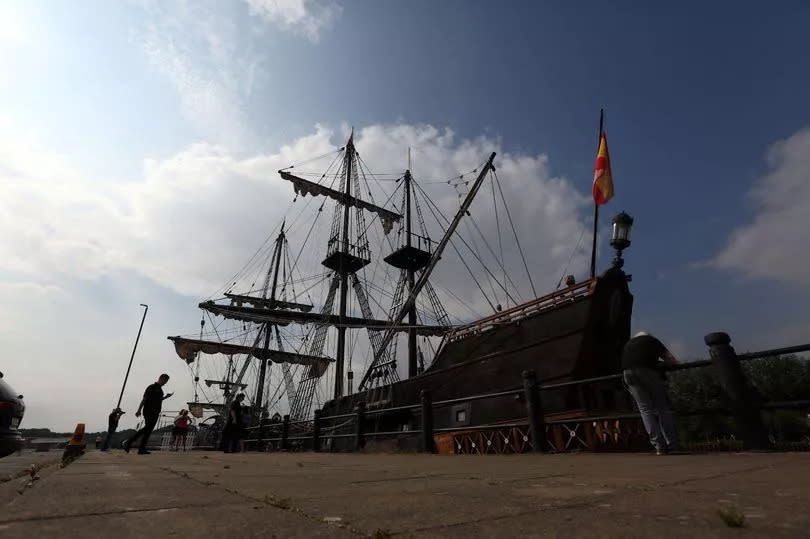We stepped on board the Spanish Galleon in Newcastle and it was like a voyage back in time

As I walk along Newcastle Quayside, I see the Spanish galleon in the distance emerging from the morning mist and it's like it has just appeared from nowhere.
It's a stunning sight. With its looming wooden hull and three towering masts, The Galeon Andalucía looks just like a pirate ship and we've been invited on board for a tour during a quiet spell before it opens to the day's visitors. Up close, the galleon - at Spillers Quay for a two-week visit - looks even more impressive.
And as I make my way along the gangplank I feel a full-on Pirates of the Caribbean vibe - although that Johnny Depp film was set a couple of hundred years later than the time these mighty vessels sailed the high seas, points out my guide. He's Alfonso Perez-Herce Garcia de Oteyza, the boatswain who has been involved with the logistics of manoeuvring this six-deck ship into dock.
Read More: Visitors expected to flock to see Shaun the Sheep in Northumberland
Get all the latest North East updates with our free What’s On newsletter
Owned by the Spanish Nao Victoria Foundation, The Galeon Andalucía is an authentic replica of a 16th Century galleon and a floating museum, currently on a tour of UK ports, which sails the world to show visitors what life was like on board for the Spanish explorers and traders who made long journeys in such vessels throughout the 16th-18th centuries.
And there's plenty to learn here about Spanish naval history too, with information on display throughout the various decks and plenty of crew around to add to its story. The first thing I notice is the smell of all the wood - oak and pine were some of the types used its epic construction - as I wander the main deck, cannons on each side and those masts and reams of ropes stretching overhead.

Alfonso shows us the admirals' room which is like stepping into a film set. Here, around a long polished table, matters of great importance would be discussed but there is a cosy armchair area too, with the likes of lanterns and candlesticks adding to the room's atmosphere. But then the whole tour is atmospheric, as we find when we move on from the main deck, now lit with sunshine which has burned away the early morning mist, and descend stairs into darkness below deck - then we're down again.
There are steep stairs to negotiate and, below sea level, there is music around us and the sound effects of lapping water which makes for an immersive experience as we explore the intimate world where galleon crewmen - and there would be hundreds in the day - would man the cannons - five on each side, for defence if needed. Laid out around us are examples of the food they would have eaten and a hammock hangs nearby, as if in readiness for an off-duty break.
There's a video playing in an even darker tucked-away space, where visitors can watch footage of a view from the bow of the galleon at sea, alongside scenes of it in full sail. Alfonso says that during the ship's journey to Newcastle from Blyth, its previous tour stop, they had been able to raise some of the ship's seven sails - but not all of them due to weather conditions.
Once it sets off from Spillers Quay on the next leg of its tour, which will be to Whitby, it will be in full sail, he says, but only when it reaches the open sea. However, lucky visitors who time it right may get to see crew members climbing the rigging and unfurling the sails during its stay.

Down a hatch and more stairs, we find an exhibition space where visitors can learn more about the galleon and how it was built. It only dates from 2009, with construction taking around 18 months, yet it both looks and feels ancient. While there are six decks - some out of sight to passers-by on the quayside - not all areas of the ship are able to view, such as the crew areas and location of the modern technology that has been added alongside the old.
There are actually two engines to help power the ship. The ship's giant wheel on the main deck is used when sailing, it requires some challenge to turn, requiring two crew, when they are on the high seas and out in the elements. Galleons, explains Alfonso, were among the first merchant ships and they were built to withstand difficult journeys and long voyages of discovery.
While visitors can learn more about wider Spanish maritime history, it's the little details such as the examples of armour on deck, and a tiny single cabin for noblemen guests who paid for the privilege, that bring home a real sense and picture of the time. There a lantern hanging high above the bow, for instance, and this would be used to give signals to other ships travelling in a convoy. It's all fascinating stuff.
Alfonso, being from Madrid, had no experience of the sea when he first joined the ship two years ago and had to soon get his sea legs and learn everything about the vessel, including how to climb up those 37-metre masts to put up the sail. "I feel like Jack Sparrow whenever I have to go up there," he admits.
Others can have a taste of life on board too, he says, as the galleon offers opportunities for visitors to sign up to join the crew on certain sections of the trip, such as an upcoming Whitby to Scarborough leg from July 16.
The Galeon Andalucía is here until July 7 and the plan is to open to visitors daily from 10am but this is dependent upon the tide. On its first day in Newcastle on Tuesday, for instance, it had to restrict access when water levels proved too low for the gangplank to be safe.
A similar issue was set to affect part of Wednesday, the day I was there, although visiting time was clearly under way on time as the end of my tour coincided with a flow of people already coming over the gangplank, with crew members out welcoming first arrivals on the quayside where tables had been laid out with memorabilia such as T-shirts for sale.
Whatever the tides over the next few days, there still will remain plenty opportunity to step on board The Galeon Andalucía before it sails off from Newcastle. Tickets can be bought on the ship or online here. Ben Whitfield, director of communications at NE1 Ltd which helped the council and Port of Tyne organise the ships visit, said it had not been without its challenges - the need to install a water supply for it being just one of them - but the hope now is to host more big vessels here in the future.
"Hopefully this is something we can expand into more visits," he said.

 Yahoo News
Yahoo News 
